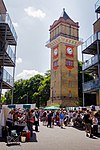Boone's Chapel
Chapels in LondonChristopher Wren buildings in LondonChurches completed in 1683Grade I listed buildings in the London Borough of LewishamGrade I listed churches in London ... and 2 more
History of the London Borough of LewishamLee, London

Boone's Chapel is a single-storey building attributed to Sir Christopher Wren and built in 1683. The chapel is very small, measuring just 45 square metres and is constructed of red brickwork with Portland stone details to window architraves, rusticated quoins and a pyramidal roof with an open wood cupola. The chapel is listed Grade I on the National Heritage List for England.It is located adjacent to the Worshipful Company of Merchant Taylors almshouses on Lee High Road in Lewisham, London and is one of only two Grade I-listed buildings in the borough of Lewisham (the other is St Paul's, Deptford).
Excerpt from the Wikipedia article Boone's Chapel (License: CC BY-SA 3.0, Authors, Images).Boone's Chapel
Lee High Road, London Hither Green (London Borough of Lewisham)
Geographical coordinates (GPS) Address External links Nearby Places Show on map
Geographical coordinates (GPS)
| Latitude | Longitude |
|---|---|
| N 51.4587 ° | E 0.0029 ° |
Address
Boone's Chapel
Lee High Road
SE13 5PL London, Hither Green (London Borough of Lewisham)
England, United Kingdom
Open on Google Maps







